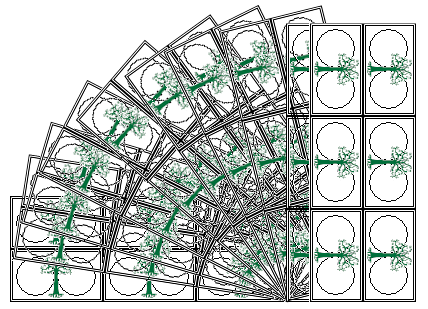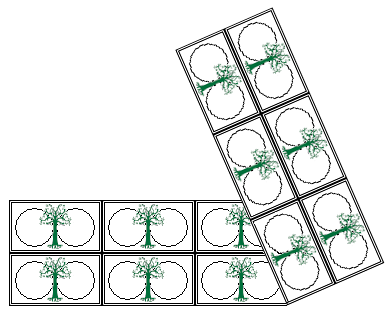During the post for the Ridiculously Hard to Kill special rule we got to see the combination of rotation and translation used multiple times. The WotR Rulebook also provides 3 examples on page 33 which are "supposed" to help clarify the types of movement that are allowed. Let's look at each of the examples that are provided and determine the movement cost that would be incurred to perform the movement example that they are providing (to determine feasibility and how it would be accomplished).
MOVEMENT EXAMPLE #1
The book reads this example as follows: "Formations can change configuration as they move, provided that none of the individual companies exceed their Move value. In example 1, the formation has taken advantage of this to turn right."
Well, the first problem is that the book doesn't mention anything about what models the formation is made-up from. There is a big difference between a formation of Riders of the Dead (that have a Move Value of 12") and a formation of Minas Tirith Knights (that have Move Value of 10"). For sake of argument, let's assume that they are using a formation of Riders of the Dead to perform the movement example shown above.
It looks like the simplest means by which to accomplish the move shown in this example would be to wheel (rotate) about the back-right corner of the formation's original position and then translate forward the distance (which measures to about 1"). This basically is shown as follows:
The formation is comprised of 6 cavalry companies in 3x2 configuration. This means that the radius of the circle created by rotation will be from the back-right corner to the front-left corner. This radius is the diagonal of the box the formation makes, which is: 270 mm x 100 mm.
So, it appears that the rotation of 90-degrees clockwise would consume 11.34" of the 12" Move Value, leaving 0.66" for the remaining translational movement. Maybe the image on page 33 is showing only a forward translation of 0.66" instead of 1" as I supposed. Ok, so it looks like this is a valid example (given that we are talking about Riders of the Dead).
Now, if it wasn't Riders of the Dead in the example, but instead Minas Tirith Knights (with a Move Value of 10") then it would have been completely different. The Minas Tirith Knights would not be able to make a full 90-degree turn with their Move Value. In fact, the maximum angle that they could rotate (via wheeling) would be 61.86-degrees. So, for the Minas Tirith Knights their Move Value would be fully consumed and look like the following.
Alternatively, instead of wheeling, we could rotate about the center of the formation and then use the remaining move value to traverse as much as possible. Running the math to see what this provides gives the following.
Visually, this would look like the image below.
Notice that the formation ends up about 1.5" back from where it would have been in the example provided. This may be more tactically advantageous then simply wheeling the 62-degrees. Again, it comes down to the desired outcome to determine the most efficient type of movement.
LINKS TO OTHER PARTS OF THE WFMC PROGRESS SERIES
- WotR Formation Movement Calculator - Work in Progress [Part 1/11]
- WotR Formation Movement Calculator - Update ... Progress still being Made [Part 2/11]
- WotR Formation Movement Calculator - WFMC Continuing to Come Together [Part 3/11]
- WotR Formation Movement Calculator - Formations Look Like REAL Formations and Groundwork for Reconfig Costs Put in Place [Part 4/11]
- WotR Formation Movement Calculator - Load Previous Data & Reconfig Costs/Restrictions [Part 5/11]
- WotR Formation Movement Calculator - Fixed Expended Move Costs Round-to-Round and Added Color to the Reconfiguration Combo Box [Part 6/11]
- WotR Formation Movement Calculator - Movement Modifier Checkboxes Work Properly and Zoom Capability [Part 7/11]
- WotR Formation Movement Calculator - Implementing the Options for Rotation [Part 8/11]
- WotR Formation Movement Calculator - Calculating the Translation Distance for Vanilla WotR Rules of Movement [Part 9a/11]
- WotR Formation Movement Calculator - Calculating the Translation Distance for Vanilla WotR Rules of Movement (Continued) [Part 9b/11]
- TBD [Part 10/11]
- TBD [Part 11/11]
LINKS TO OTHER PARTS OF MOVEMENT TYPES AND LIMITS SERIES
- Movement Types and Limits Series - Reconfiguration Movement of Infantry Formations Comprised of 2-3 Companies [Part 2/23]
- Movement Types and Limits Series - Reconfiguration Movement of Infantry Formations Comprised of 4 Companies [Part 3/23]
- Movement Types and Limits Series - Reconfiguration Movement of Infantry Formations Comprised of 5 Companies [Part 4/23]
- Movement Types and Limits Series - Reconfiguration Movement of Infantry Formations Comprised of 6 Companies [Part 5/23]
- Movement Types and Limits Series - Reconfiguration Movement of Infantry Formations Comprised of 7 Companies [Part 6/23]
- Movement Types and Limits Series - Reconfiguration Movement of Infantry Formations Comprised of 8 Companies [Part 7/23]
- Movement Types and Limits Series - Reconfiguration Movement of Infantry Formations Comprised of 9 Companies [Part 8/23]
- Movement Types and Limits Series - Reconfiguration Summary of Infantry Formations by Company Size [Part 9/23]
- Movement Types and Limits Series - Infantry Restrictions of Reconfiguration by Formation Name Summary [Part 10/23]
- Movement Types and Limits Series - Reconfiguration Movement of Cavalry Formations Comprised of 2-3 Companies [Part 11/23]
- Movement Types and Limits Series - Reconfiguration Movement of Cavalry Formations Comprised for 4 Companies [Part 12/23]
- Movement Types and Limits Series - Reconfiguration Movement of Cavalry Formations Comprised of 5 Companies [Part 13/23]
- Movement Types and Limits Series - Reconfiguration Movement of Cavalry Formations Comprised of 6 Companies [Part 14/23]
- Movement Types and Limits Series - Reconfiguration Movement of Cavalry Formations Comprised of 7 Companies [Part 15/23]
- Movement Types and Limits Series - Reconfiguration Movement of Cavalry Formations Comprised of 8 Companies [Part 16/23]
- Movement Types and Limits Series - Reconfiguration Movement of Infantry Formations Comprised of 9 Companies [Part 17/23]
- Movement Types and Limits Series - Cavalry Movement Example 1 from Page 33 of WotR Rulebook Analysis [Part 18/23]
- Movement Types and Limits Series - Cavalry Movement Example 2 from Page 33 of WotR Rulebook Analysis [Part 19/23]
- Movement Types and Limits Series - Cavalry Movement Example 3 from Page 33 of WotR Rulebook Analysis [Part 20/23]
- Movement Types and Limits Series - Reconfiguration Summary of Cavalry Formations by Company Size [Part 21/23]
- Movement Types and Limits Series - Cavalry Restrictions of Reconfiguration by Formation Name Summary [Part 22/23]
- Using WFMC to Verify Movement Examples [Part 23/23]






No comments:
Post a Comment